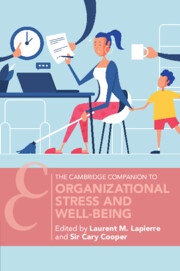Book contents
- Organizational Stress and Well-Being
- Cambridge Companions To Management
- Organizational Stress and Well-Being
- Copyright page
- Contents
- Figures
- Tables
- Contributors
- Introduction
- Part I Historical Evolution and Continued Relevance of the Study of Organizational Stress and Well-Being
- Part II Line Managers
- Part III Major Issues Relating to Stress and Well-Being
- Part IV Workplace Interventions Addressing Stress and Well-Being
- Part V Emerging Issues
- Subject Index
- References
Part IV - Workplace Interventions Addressing Stress and Well-Being
Published online by Cambridge University Press: 23 February 2023
- Organizational Stress and Well-Being
- Cambridge Companions To Management
- Organizational Stress and Well-Being
- Copyright page
- Contents
- Figures
- Tables
- Contributors
- Introduction
- Part I Historical Evolution and Continued Relevance of the Study of Organizational Stress and Well-Being
- Part II Line Managers
- Part III Major Issues Relating to Stress and Well-Being
- Part IV Workplace Interventions Addressing Stress and Well-Being
- Part V Emerging Issues
- Subject Index
- References
Summary

- Type
- Chapter
- Information
- Organizational Stress and Well-Being , pp. 387 - 438Publisher: Cambridge University PressPrint publication year: 2023



